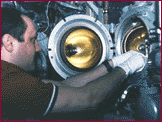



Objectives
The objectives of this experiment were: (1) to study the affect of microgravity on the formation of defects (voids) in sintered products, wetting and alloy formation, and grain sizes and shapes, (2) to analyze the effects of wetting and alloy formation, and (3) to study grain sizes and shapes.
Shuttle-Mir Missions Approach Results Earth Benefits Publications
"Preliminary Results From Liquid Phase Sintering Aboard the Russian Mir Station", with He, Y, Ye, S., Kuruvilla, A., and Smith, J. To appear, Proceedings of SpaceBound 97, Montreal Canada, May 11-15, 1997.
"High Temperature Liquid Phase Sintering: OLIPSE-01," with He, Y., Ye, S.and Smith, J., Proceedings of the Phase 1 Research Program Interim Results Symposium, Microgravity and Materials Sciences Section, pp 61-74, August 5-7,1997.
He, S. Ye, A. K. Kuruvilla, and J.E. Smith Jr., "Preliminary Results from Liquid Phase Sintering Studies Aboard Russian Mir Station", 9th International Symposium on Experimental Methods for Microgravity Materials Science, TMS publication (in CD-ROM format), compiled and edited by Dr. Robert A. Schiffman. 1997.
Principal Investigators![]()
NASA-2, NASA-6, NASA-7
OLiPSE investigated liquid phase sintering (LPS) in metallic alloys in microgravity. LPS is widely used in industrial powder-metallurgy processes. Sintering takes place when a solid-state metal constituent transitions from a solid to a liquid upon heating and mixes with a separate solid-state metal. OLiPSE samples were processed in the Optizone high temperature furnace available in the Kristall module of the Mir Space Station. OLiPSE samples consisted of Cu-Fe, Cu-Co, and Cu-Ni-W. Prior to sample processing, the Optizone was calibrated with a copper wire surrounded by iron/copper. Optimal power was determined by comparing melt times with a furnace located on the ground at Star City, Russia.
During NASA-2, 16 sample ampoules, two calibration sample ampoules, and on-orbit support equipment were carried aloft on STS-76; the samples were processed between March 30 to April 20,1996. Of the the 16 sample ampoules, 13 ampoules were processed. On NASA-6, during the calibration of Optizone furnace, it was learned that Optizone was malfunctioning, so the project was moved to NASA-7.
The failure of mechanical parts is often traced back to the manufacturing process that was used to make the part. Sintering of metals is one process that industries use to make materials. Liquid phase sintering experiments in microgravity may provide greater understanding of alloy behavior and pore break-up in metal composites. Commercial industries may benefit from improved understanding of metal composites. Sintered metals, such as tungsten, are used for such exotic applications as filaments in electric lights, precision cutting tools or contact-points in high-voltage electric switches.
"Optizone Liquid Phase Sintering Experiments (OLiPSE-01) Aboard the Mir Station: Performance and Preliminary Results", with He, Y., Ye, S., Kuruvilla, A., Savin, S., Ivanov, A., Markov, E, Andropov, V., Bratukin, U. Putin, G. and Smith, J., Proceedings of the Joint Xth European and VIth Russian Symposium on Physical Sciences in Microgravity, pp 133-135, St. Petersburg Russia, June, 1997.
James Smith, Ph.D.
University of Alabama at Huntsville
![]()
|
|
Curator:
Julie Oliveaux
Responsible NASA Official: John Uri |
Page last updated: 07/16/1999
.gif)